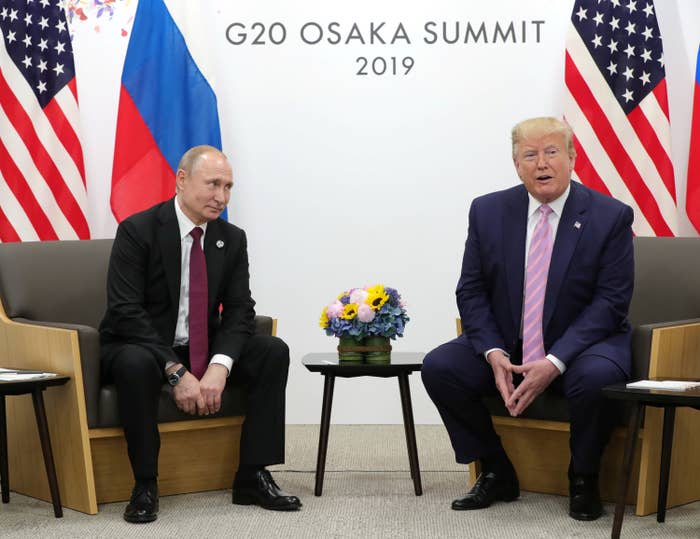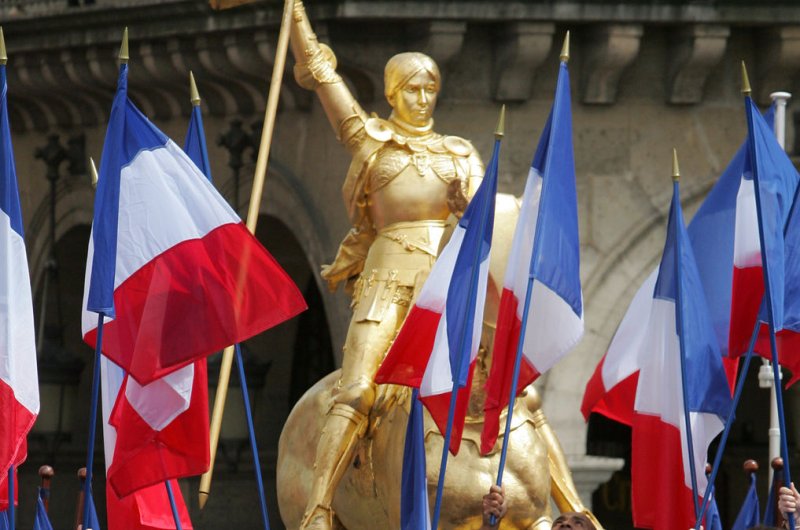Russia Sold The US A Bunch Of Ventilators That Never Got Used. The Same Model Just Burst Into Flames And Killed Six People In Russia.
FEMA is waiting for the results of a Russian investigation into two deadly fires before any future use of the ventilators sold to the US by Moscow.
Christopher Miller BuzzFeed News Contributor
Posted on May 12, 2020

Sputnik Photo Agency / Reuters
Vladimir Putin and Donald Trump at the G20 summit in Osaka, Japan, on June 28, 2019.
They were delivered in crates stamped “from Russia, with love.”
But dozens of ventilators sent from Moscow to New York and New Jersey to help their hospitals respond to the coronavirus outbreak have gone unused — and will now be handed over to federal authorities.
“New York State received 30 ventilators from Russia, but thanks to the success of our efforts to contain the COVID-19 pandemic, they were not needed. They will be returned to FEMA soon,” Jonah Bruno, director of communications for the New York State Department of Health, told BuzzFeed News on Tuesday, referring to the Federal Emergency Management Agency.
The situation was similar across the Hudson River.
“15 ventilators were received. They have not been used to date, mainly for electrical compatibility issues,” said Donna Leusner, director of communications for the New Jersey State Department of Health.
US equipment is designed to handle 110 volts, whereas Russian equipment is designed for 220-volt electricity.
A FEMA spokesperson told BuzzFeed News the Russian ventilators were delivered to warehouses owned by the two states. “Thankfully, the flattening curve meant these ventilators were not needed, but they were held in reserve in case the situations in NY and NJ worsened. The ventilators have not been deployed to hospitals,” the spokesperson said.
The US may have caught a lucky break by not using the ventilators, since two of the same models burst into flames in Russian hospitals in the past week, killing six people. Russian authorities have launched an investigation into the fires.
The FEMA spokesperson said they are aware of those fires and that the states are returning the ventilators to it “out of an abundance of caution.”
“The conclusion(s) of the investigation being conducted by the Russian authorities into the fire in St. Petersburg will help inform our decision regarding any future use of the ventilators,” the spokesperson added. The second fire occurred in Moscow.
New York, the US state hit the hardest by the pandemic, has recorded a total of 342,267 cases of the coronavirus and 27,003 related deaths, according to data compiled by Johns Hopkins University. New Jersey has reported 140,743 cases with 9,508 deaths.
Ventilators have become a symbol of the global coronavirus pandemic, representing the last hope for some people with severe cases of COVID-19. But some doctors have raised concerns about the overuse of the breathing machines — which require patients to be intubated — and said they may be doing more harm than good in some cases.
In March and early April, many state officials across the US warned President Donald Trump that they lacked sufficient ventilators to deal with the looming crisis. Trump soon got into a war of words with governors over the federal supply, boasted about ramping up production, and even called the US the “king of ventilators.”
The Russian ventilators were sent by Moscow to the US last month after a series of calls between Presidents Trump and Vladimir Putin, and as New York Gov. Andrew Cuomo said he feared the state could face a shortage of the devices. They were part of a medical aid shipment that caused a wave of criticism and confusion. It was first billed as free assistance but later Russia said it had charged the US $660,000 for the medical supplies, which included disinfectant, masks, and gloves.
“As a follow-up to the March 30 phone call between President Trump and President Putin, the United States has agreed to purchase needed medical supplies, including ventilators and personal protection equipment, from Russia, which were handed over to FEMA on April 1 in New York City,” State Department spokesperson Morgan Ortagus said in a statement.
Forty-five ventilators were sent from Russia and included several of a particular model called Aventa-M. That model, built by the Ural Instrument Engineering Plant (UPZ) in Chelyabinsk, 930 miles east of Moscow, was reported by Russian media to have caused two deadly fires at hospitals treating coronavirus patients in less than a week.
Five people were reportedly killed at a hospital treating coronavirus patients in St. Petersburg on Tuesday when an Aventa-M ventilator burst into flames, causing an intensive care unit to catch fire. Days earlier, a ventilator caused a fire in the intensive care unit of a Moscow hospital, killing one woman.
After the latest incident, Russia’s healthcare watchdog, Roszdravnadzor, launched an investigation to check the quality and safety of the Aventa-M ventilators and said it would stop using the model for now.
News of the ventilator fires in Russia came as Putin’s longtime spokesperson said he himself had been hospitalized after testing positive for the coronavirus.
Dmitry Peskov told the Interfax news agency on Tuesday, “Yes, I’ve gotten sick. I’m being treated.”
Peskov, 52, has been Putin's spokesperson since 2008. Kremlin pool reporters said that he last saw Putin in person on April 30, within the 14-day window of time that the World Health Organization says carriers of coronavirus can be asymptomatic. By the WHO's own definition, that would make Putin a “contact” who health experts say should self-isolate for 14 days.
It was unclear, however, whether the two men were physically in the same room. Peskov told Russia’s TASS news agency on Tuesday that he hadn’t seen Putin in person in “more than a month.”
Putin has limited in-person meetings since the start of Russia’s coronavirus outbreak and has been mostly confined to his residence, where he conducts official business by videoconferencing.
Peskov’s wife, Tatiana Navka, a Russian Olympic ice dancing champion, has also tested positive for the coronavirus and been hospitalized, according to local media. She seemed to be surprised by her and her husband’s diagnosis and was quoted as saying that her “whole family was in strict isolation” when they received their coronavirus test results.
“My husband was working. In this regard, there is only one explanation: most likely, this came from him, since he was the first to get sick. He brought it home from work,” she said.
Peskov is at least the fourth Russian official to become infected with the coronavirus. In late April, Prime Minister Mikhail Mishustin told Putin during a live videoconference with members of the government that he had tested positive. Days later, Construction Minister Vladimir Yakushev and Culture Minister Olga Lyubimova both tested positive.
Just one day before his spokesperson announced he had been infected with the coronavirus, Putin announced the easing of a nationwide lockdown imposed in March to stop the spread of it and said that Russians should get back to work. The announcement came even as the country reported a record-high number of infections, making it Europe’s new hot spot.
On Tuesday, Russia had recorded a total of 232,243 cases of the coronavirus, according to a global case tracker, placing it just behind the US for the most cases in the world.

Christopher Miller is a Kyiv-based American journalist and editor.






















